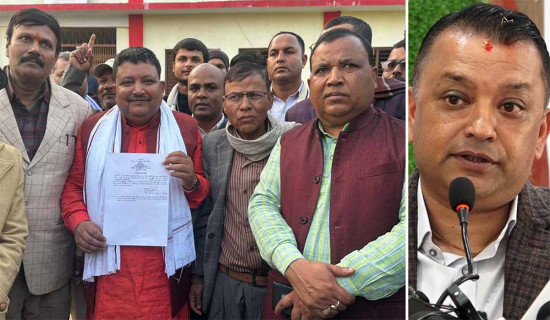- Wednesday, 21 January 2026
Climate-resilient Farming
Paddy plantation is now at its peak across the country, with the continuous rains that remain the key source of irrigation for the arable land. Nepali farmers have to wait for the arrival of the monsoon to soak and mobilise the soil before starting the plantation of seedlings of paddy. The rainy season brings both joy and sufferings to the farmers. The monsoon delights them as it enters from the eastern part of the country but it also wreaks havoc with the lives of the people and properties. The fragile land and ill-planned infrastructure are blamed for the rain-induced casualties and damage. Nepalis have been accustomed to live with this duality of nature for ages. Nonetheless, timely rainfall is a boon for the farmers. And paddy plantation marks significant moment as it bears social, economic and cultural dimensions.
Rice is the staple food of Nepalis and Nepal ranks 13th globally in terms of rice consumption. Rice-eating habit is very strong among the Nepalis although there is growing health awareness of taking balanced diet. It accounts for 23 per cent of protein intake with 138 kg annual per capita consumption. Rice alone contributes around 15 per cent to the agriculture GDP and 5 per cent to the overall GDP. Agriculture’s share in the national GDP stands at around 24 per cent, with over 62 per cent of households relying on it for their livelihood. In addition, the production of rice in the desired quantity ensures food and nutrition security. Although the monsoon has now become hyper active, paddy has been reportedly planted only in about 22 per cent of the total paddy field of 1.4 million hectares by July 2 this year, thanks to the erratic rainfall pattern that has become the norm, rather than the exception.
Though the state faces problems in providing the basic inputs such as irrigation, fertilisers, hybrid seeds, modern equipment and subsidies, among others, Nepal's climate and topography are suitable for the production of varieties of rice. They are grown in the terraced field of the hills to the plains of Tarai. Official data shows there is a gradual increase in the production of rice in the recent years. However, the country has to import around 750,000 tonnes of rice annually to meet the deficit, which is the 15 per cent of the total consumption. There has been a tendency to consume fine rice instead of coarse one, resulting in the increase in its import. Attaining self-reliance on food production has been confined to political slogan as proper incentives and investment in the agriculture sector are sorely lacking. Our economic policy that minimises the state's role in catering the basic services to the citizens is largely responsible for the import dependency of food.
Climate change has posed an additional challenge to agricultural activities. It has not only disrupted the rainfall pattern but also dried up water sources and intensified droughts. Short rainfall and heavy downpours are detrimental to farming, like any other sector. Bearing in mind the negative impacts of climate change, this year the government marked the National Paddy Day with the theme of 'climate resilient farming, increase in paddy production'. This naturally calls for using climate-friendly technology and seeds, diversifying crops and enhancing the storage capacity. Similarly, the initiative needs to be taken to expand the areas of Chaite paddy and implement the land use policy. We need comprehensive strategy that promotes technological innovation and policy reforms for food security and self-sufficiency.

















